
Looking for Blueberry Varieties - Characteristics, Ripening Order and More in 2025? Scroll down this page and follow the links. And if you bring home some fruit or vegetables and want to can, freeze, make jam, salsa or pickles, see this page for simple, reliable, illustrated canning, freezing or preserving directions. There are plenty of other related resources, click on the resources dropdown above. If you are having a hard time finding canning lids, I've used these, and they're a great price & ship in 2 days.
If you have questions or feedback, please let me know! There are affiliate links on this page. Read our disclosure policy to learn more.
Blueberry Varieties - Characteristics, Ripening Order and More
Blueberry Varieties 
The first cultivated blueberries were developed in New Jersey in the early 1900's. Since, many plant breeders have developed new varieties, suitable for growing in almost all parts of North America and Europe. They have different ripening dates, flavor variations and even different colors, aside from blue!
Major branches of the blueberry family
There are 4 main types of blueberries:
- Northern Highbush blueberry varieties which grow best in the northern U.S. and Canada
- Southern Highbush blueberries do well in moderate areas like southern parts of the north and the northern parts of the South (think TN, KY, VA, NC, and west coast) but they are not as commonly grown as either northern highbush nor rabbiteye types.
- Rabbiteye Blueberries are best suited for the Southeast, and the Southern Hemisphere.
- Lowbush - typically wild varieties. More commonly grown in Maine and other parts of New England. Intense flavor.
Similar berries: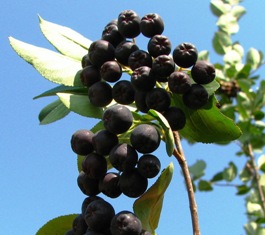
While the true blueberry is a native American, there are similar berries around the world. Most are closely related to blueberries
- Aroniaberries - also called Chokecherries
- Bilberries - smaller cousins of the blueberry in Europe
- Blaeberry in Scotland and Ireland, smaller, intense flavor; like a bilberry-
- Honeyberries - Honeyberries are not related to blueberries, but they are blue berries! Related to honeysuckle,(Lonicera caerulea) they are also called haskap berry, blue-berried honeysuckle, deepblue honeysuckle, and sweetberry honeysuckle They are edible with an unusual sweet and tart flavor.
- Huckleberries - larger blue berries, a bit less sweet, common to the northern US and Canada
- Saskatoons - Canadians know about Saskatoons. They are native to western
Canada and the northwest of the U.S.. They are larger, a bit
less sweet; almost identic
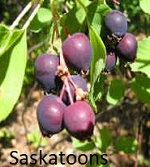 al to a Huckleberry, with a hint of
apple.
al to a Huckleberry, with a hint of
apple. - Serviceberries - another name for Saskatoons
- Whorlberry or whortleberry grown in the United Kingdom. Much like a bilberry.
Varieties of Blueberries in general order of ripening
Since the varieties planted are selected for the climate and area, we've grouped these to be most useful to you, by their general type followed by order of ripening. Keep in mind, the actual ripening dates and even the order can vary considerably from farm to farm, year to year, state to state; so take this as general order!
Northern Highbush Blueberries
Northern highbush blueberries are generally self-fertile (a.k.a., self-pollinating); but you will get larger and earlier ripening berries if you plant several different cultivars (varieties) close by for cross-pollination. For those in the northeast, see Rutgers University Blueberry Growing Guide
Below,
Alphabetical within season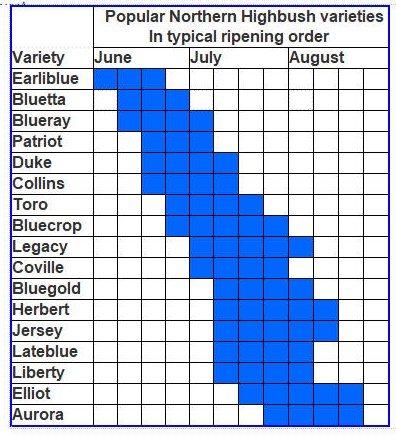
Early season
- Bluetta - very hardy, small dark berries
- Collins - medium size, light blue berries with excellent quality is excellent.
- Duke - large, easy to pick. Mild, low acidity. Get Duke blueberry plants here.
- Earliblue (or Early Blue) - one of the earliest, very popular
- Hannah's Choice - medium large fruit with high sugar content, firmer, better flavored than Duke.
- Reka - Medium size with strong huckleberry-like flavor. Produces large crops. Get Reka blueberry plants here
- Spartan - firm and very large, very good flavor. later than other early varieties, large crop.
- Sunrise - Large size and excellent flavor, not as heavy yielding as Duke
Late Early to early Mid-season
- Patriot - large, firm berries, early bloom, but more midseason ripening.
- Toro - large size, easy to pick, good flavor.
- Weymouth - excellent flavor, a derivative of the wild varieties .
Mid-season
- Berkeley - light blue, firm and very large with very good storing but only average flavor
- Bluecrop - Medium to large size, variable picking; old variety taste.
- Bluehaven
- Bluejay - moderate crops of large sized, high quality fruit. Very popular for home growing and U-Pick Get Blueray blueberry plants on Amazon here
- Blueray - medium size with good flavor and high yields
- Cara's Choice - medium sized fruit with 30% more sugar than Duke or Bluecrop and the berries stay good on the plant for an extended period
- Chippewa - large firm fruit, productive and winter hardy
- Draper - very good flavor
- Hardyblue - Small size but easy to pick; sweetest berry. Good for cooking.
- Legacy - Large, firm, sweet, aromatic, excellent flavor and stores well
- Northland - medium sized, dark,s oft berries; extremely productive
- Nui - Very large size and excellent flavor but light yields
- Olympia - Medium to small size, excellent flavor
- Rubel- derived from a wild variety, small, firm, dark berries, similar to low bush varieties, but only average flavor
- Sierra - large firm berries
Mid to late season
- Bluegold - Medium to large size, yields vary from season to season
- Chandler - Very popular due to its large size and good flavor. Get Chandler blueberry plants here.
- Darrow - Their size varies, easy to pick; excellent flavor. /li>
- Nelson - Large size, very good flavor, the berries can stay on the bush for extended periods.
Late season
- Aurora - a new variety, 5 days after Elliot; firm , large berries that store well; very good yield.
- Brigitta - large, firm, flavorful fruit that stores well. The plant grows late into the fall
- Coville - Large, firm, highly aromatic, tart, very good flavor
- Elliot - Late season, large size, easy to pick; tart flavor. Very good shelf life, 30-45 days in a fridge, Beware not to pick early, turns blue before ripe. Get Elliot blueberry plants here.
- Liberty - ripens 5 days before Elliot with better flavor. Stores well
- Jersey - an old cultivar dating to 1928, small, soft berries. Get Jersey blueberry plants here.
Southern Highbush Blueberries
Don't let the name fool you; while these can be grown in hot climates, they are still more difficult than rabbiteye varieties and are better suited for warmer areas of the North. If you do plant these, you should plant several different cultivars (varieties) of them close by for cross-pollination
Early season:
- Suziblue
- Palmetto
- O'Neal
Mid-season
- Biloxi - Grows well in the deep South, Texas and California. Light blue medium-sized firm berries. Get Biloxi Southern Highbush Blueberry plants here.
- Camellia
- Emerald - the most popular and frequently planted Southern Highbush blueberry variety. You can get a 4-pack of Emerald Southern Highbush blueberry plants here.
- Jubilee
- Magnolia
Rabbiteye Blueberry Varieties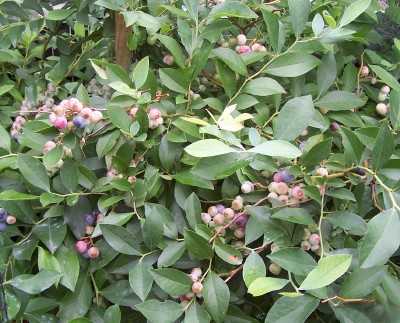
Be sure to plant more than one variety for cross-pollination to ensure good fruit setting. This is important for Rabbiteye's! See this UGa article for information about growing rabbiteye blueberries Also, this article by Texas A and M has more Rabbiteye Blueberry Growing information. And for those on the west coast, see this SFGate Article about Rabbiteye Varieties
Early season
- Austin - large, blue firm berries with good flavor,
- Alapaha - medium sized with good flavor and smaller seeds
- Climax - large, medium-dark blue and good flavor.This is a very reliable blueberry for the Deep South. Get Climax blueberry plants here.
- Delite - small and light blue, pretty but not a consistent producer
- Montgomery - very productive, medium to large berries, good firmness and flavor
- Premier - Large berries with good flavor. The plants are vigorous, disease resistant, and productive.
- Prince - blooms a few days before Climax, medium sized berries, with good color, firmness and flavor
- Savory - large berries with light blue color, and good firmness and flavor, but the plant is susceptible to fungus.
- Titan - largest berries
- Vernon - large berries
- Woodard - large, light blue.
Late early to early mid-season
- Briteblue - moderately vigorous, firm, large, light blue berries, good producer.
Mid-season
-
Becki Blue - Very good crops of tasty berries; this is a popular southern variety.. Grows 6-10 feet tall and 6-8 feet wide, which makes it a great
hedge, too. Get
Becki Blue blueberry plants here.
Sun Exposure: These rabbiteye blueberry plants flourish in full sun, thriving in sunny locations while ensuring the best fruit production and flavor.
USDA Growing Zone: Well-suited for USDA zones 7-9, providing enduring beauty and delicious fruit in a range of climates.
Fruit: Large, juicy berries ripen in mid to late summer, offering a delectable treat for snacking, baking, or preserving. - Brightwell - medium in size, medium blue color, vigorous plants that produce many new canes. Get Brightwell blueberry plants here.
- Garden Blue - very small, light blue berries
- Powderblue - disease-resistant, and productive, similar to Tifblue but more leafy plant, holds up to rainy periods better. Get Powder Blue blueberry plants here.
- Tifblue - large, round, light blue, sweet, very firm, stays good on the plant for days, most productive of all rabbiteye varieties. Get Tifblue blueberry plants here.
Late season
- Baldwin - good flavor and firm, dark blue fruit; with a long ripening period; good for home gardeners and U-pick
- Centurion - Ripens after Tifblue; good flavored berries, medium firmness, darker than Tifblue..
- Ochlockonee - medium sized with good flavor and smaller seeds. Get Ochlockonee blueberry plants here.
- Sharpblue - developed at the University of Florida for areas receiving 600 hours or less of temperatures below 45 degrees.
New Pink Rabbiteye Varieties
- Pink Lemonade - Pink blueberries, with a great, very sweet flavor. You can purchase Pink Lemonade blueberry plants here.
- Pink Champagne - Even better than pink Lemonade, in my opinion (but harder to find the plants); more antioxidants and sweeter than blue blueberries. You can purchase Pink Champagne blueberry plants here.
Blueberry pests
If you pick blueberries and have seen little white worms in the berries: That is most likely SWD, spotted wing drosophila, the grub or larval form of a fly. See this page about Spotted Wind Drosophila, identification and controls
Lowbush varieties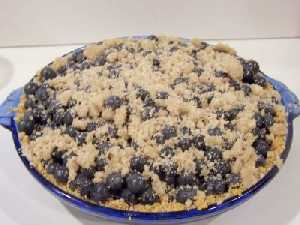
Generally only growing up to 18 inches tall
- Top Hat is- used for ornamental landscaping
- Ruby carpet - grows well in USDA zones 3-7.
Blueberry Recipes
- The world's best Blueberry pie, recipe and directions and illustrated!
- Blueberry buckle coffee cake: illustrated directions for this great crumb-topping blueberry coffee cake
- Other easy directions to make blueberry desserts: cobblers, etc.
Canning and freezing Blueberries:
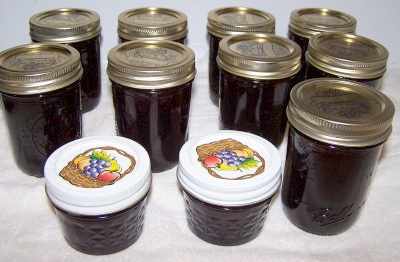
- How to Freeze Blueberries
- How to Can Blueberries
- How to Make Homemade Blueberry Jam
- How to make blueberry jelly
- How to make and can blueberry syrup (it works for strawberries, raspberries and blackberries, too)
- blueberry pie filling to use later,
- blueberry butter
Looking for canning equipment and supplies?
Water bath canner with a jar rack
Pressure canners for gas, electric and induction stoves: Presto 23Qt or T-fal 22Qt
Canning scoop (this one is PERFECT)
Ball Blue book (most recent version)
Jars: 8oz canning jars for jams
Find Other types of farms:
Farm markets and roadside stands
Road trips and camping resources
Local Honey, apiaries, beekeepers
Consumer fraud and scams information
Home canning supplies at the best prices on the internet!
Maple Syrup Farms, sugarworks, maple syrup festivals
Environmental information and resources
Farms For Your Event for birthday parties, weddings, receptions, business meetings, retreats, etc.
Festivals - local fruit and vegetable festivals
Get the
most recent version of
the Ball Blue Book
With this Presto 23 quart pressure canner and pressure cooker, you can "can" everything, fruits, vegetables, jams, jellies, salsa, applesauce, pickles, even meats, soups, stews. Model 01781

You can make jams, jellies, can fruit, applesauce, salsa and pickles with water bath canners, like this Granite Ware 12-Piece Canner Kit, Jar Rack, Blancher, Colander and 5 piece Canning Tool Set

